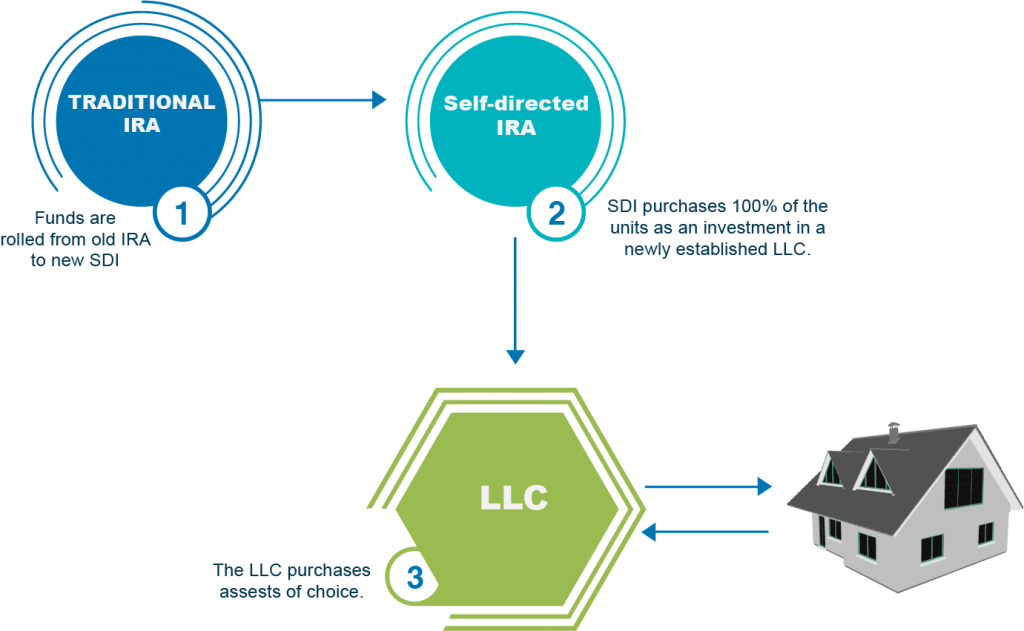


Savvy investors often utilize the self-directed IRA when saving for retirement.
The self-directed IRA (available in both traditional IRA and Roth IRA structures) offers significant flexibility compared to traditional custodian-based IRAs.
When paired with turnkey real estate investing, it can prove to be a robust strategy for building wealth and saving on taxes.
Here we discuss using a self-directed IRA to invest in turnkey real estate and how this combination can help you better maximize your returns with effective retirement account tax sheltering.
A self-directed IRA LLC is a type of individual retirement account that allows for a broader range of investments than what has typically been available in traditional IRAs.

While traditional IRAs, particularly those established by an employer, typically limit you to the stock market, bonds, and mutual funds, a self-directed IRA opens the door to various other assets, including real estate, precious metal and even private placements and private equity.
The key difference between the two lies in the investment choices available.
For instance, traditional IRAs are managed by custodians who often restrict investments to standard financial products or worse, products proprietary to their organization.
In contrast, self-directed retirement accounts are managed by IRA custodians who allow for a wider array of investment opportunities.
This flexibility on your choice of investments can be advantageous for investors looking to diversify their portfolios beyond conventional assets.
A self-directed IRA can offer several benefits to investors:
While self-directed investors have more flexibility and choice when it comes to where their retirement funds are placed, it is crucial to understand the rules and restrictions to avoid prohibited transactions.
Turnkey and sight unseen real estate investing involves purchasing properties that are either newly-developed or fully renovated and managed by a professional property management team.
These properties are either already rented and stabilized as a cash-flowing asset or they are ready to rent out, providing investors with a hassle-free way to earn passive income from the outset.
Combining a self-directed account with turnkey real estate investing offers several advantages.
Setting up your self-directed IRA for investing in turnkey real estate is as simple as finding a custodian and funding the account.
In choosing a custodian, there are a myriad of options, but we typically advise toward the least expensive option as custodians are somewhat of a commodity service.
Once the account is set up with "checkbook control" (often referred to as a checkbook IRA LLC) you can start (within the confines of typical IRA limitations discussed further below) investing in alternative assets.
A typical self-directed retirement account can be funded from a rollover from one or more other IRAs or 401(k) accounts.
Non-recourse lending is a type of loan that is secured by collateral, typically real estate, but where the borrower is not personally liable in the event of default.
In the context of a self-directed account, this means that if the borrower defaults on the loan, the lender can only seize the collateral property, not any other assets of the IRA or the investor.
This is a critical feature when acquiring leveraged properties (i.e. not "all cash" deals) with an IRA since IRS regulations prohibit personal guarantees on loans within your IRA.
When using a self-directed IRA to invest in real estate, non-recourse loans are essential because they comply with IRS rules that prevent the account holder from personally guaranteeing any loan taken by the IRA.
Non-recourse lending allows the IRA to leverage its purchasing power without violating these IRS regulations, enabling investors to acquire higher-value properties and potentially achieve greater returns with the accompanying leverage.
However, there are a very narrow sub-set of lenders that will actually allow for non-recourse loans and the underwriting standards are typically more restrictive and cumbersome than typical real estate financing.
Because many of the IRS rules surrounding self-directed IRAs are strict and breaking of those rules can, in some cases, disqualify the entire IRA, it is best always to get the advice of experienced legal counsel when discussing your real estate investments.
While there are many advantages to using a self-directed IRA to invest in turnkey properties, it is essential investors understand all the rules that can impact the viability of a transaction in acquiring real estate with an IRA.
The IRS has strict rules on prohibited transactions (structure and type) and disqualified persons (or those who can invest alongside the IRA LLC).
Violating these rules can result in severe tax and legal penalties.
Ensure all transactions and management practices comply with IRS guidelines to avoid penalties and preserve the tax-advantaged status of your IRA.
Select a custodian with experience in self-directed IRAs and real estate investments.
Work with legal and financial advisors to understand and comply with all regulations.
Diversify your investments and conduct thorough due diligence to mitigate risks.
Exploring real-life examples of successful investments can provide valuable insights and inspiration. Here are a few case studies:
Using a self-directed IRA to invest in turnkey real estate can be a powerful strategy for building wealth and securing a comfortable retirement.
By understanding the process, adhering to legal guidelines, and conducting thorough due diligence on how you spend and invest your retirement savings, you can maximize your investment returns and enjoy the benefits of both tax-deferred growth and passive income.
For further reading and expert guidance, consider the following resources:
For personalized advice and assistance, feel free to contact us at Invest.net.
Our team of experts is here to help you navigate the complexities of self-directed IRA investing and achieve your financial goals.

Nate Nead is the Founder and Principal of HOLD.co, where he leads the firm’s efforts in acquiring, building, and scaling disciplined, systematized businesses. With a background in investment banking, M&A advisory, and entrepreneurship, Nate brings a unique combination of financial expertise and operational leadership to HOLD.co’s portfolio companies. Over his career, Nate has been directly involved in dozens of acquisitions, spanning technology, media, software, and service-based businesses. His passion lies in creating human-led, machine-operated companies—leveraging AI, automation, and structured systems to achieve scalable growth with minimal overhead. Prior to founding HOLD.co, Nate served as Managing Director at InvestmentBank.com, where he advised middle-market clients on M&A transactions across multiple industries. He is also the owner of several digital marketing and technology businesses, including SEO.co, Marketer.co, LLM.co and DEV.co. Nate holds his BS in Business Management from Brigham Young University and his MBA from the University of Washington and is based in Bentonville, Arkansas.